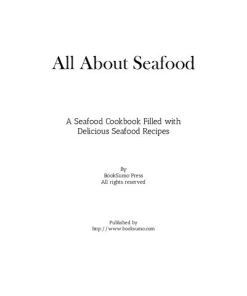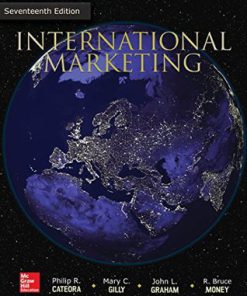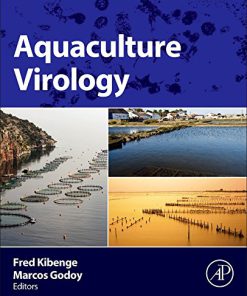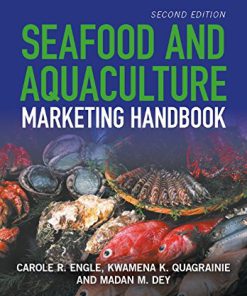Seafood and aquaculture marketing handbook 1st edition by Carole Engle, Kwamena Quagrainie, Madan Dey 1118859278 9781118859278
$50.00 Original price was: $50.00.$25.00Current price is: $25.00.
Seafood and aquaculture marketing handbook 1st edition by Carole R. Engle, Kwamena K. Quagrainie, Madan M. Dey – Ebook PDF Instant Download/DeliveryISBN: 1118859278, 9781118859278
Full download Seafood and aquaculture marketing handbook 1st edition after payment.

Product details:
ISBN-10 : 1118859278
ISBN-13 : 9781118859278
Author: Carole R. Engle, Kwamena K. Quagrainie, Madan M. Dey
Aquaculture, the farming of aquatic animals and plants, and other seafood businesses continue to grow rapidly around the world. However, many of these businesses fail due to the lack of sufficient attention to marketing. The Seafood and Aquaculture Marketing Handbook provides the reader with a comprehensive, yet user-friendly presentation of key concepts and tools necessary for aquaculture and seafood businesses to evaluate and adapt to changing market conditions. Markets for aquaculture and seafood products are diverse, dynamic, and complex. The Seafood and Aquaculture Marketing Handbook presents fundamental principles of marketing, specific discussion of aquaculture and seafood market channels and supply chains from around the world, and builds towards a step-by-step approach to strategic market planning for successful aquaculture and seafood businesses. This book is an essential reference for all aquaculture and seafood businesses as well as students of aquaculture. The volume contains a series of synopses of specific markets, an extensive annotated bibliography, and webliography for additional sources of information. Written by authors with vast experience in international marketing of aquaculture and seafood products, this volume is a valuable source of guidance for those seeking to identify profitable markets for their aquaculture and seafood products.
Seafood and aquaculture marketing handbook 1st Table of contents:
Chapter 1: Seafood and aquaculture markets
Global trends in seafood and aquaculture markets
Are aquaculture products different from agriculture products?
Aquaculture market synopsis: tilapia
Summary
Study and discussion questions
References
Chapter 2: Demand and supply: basic economic premises
What is economics?
Demand
Supply
Price determination
Elasticity
Market structures and implications for competition and pricing
Special demand and supply conditions
Aquaculture market synopsis: salmon
Summary
Study and discussion questions
References
Chapter 3: Seafood and aquaculture marketing concepts
What is marketing?
Marketing plan
Market products
Supply chain and value chain
Processors
Market or distribution channels
Transportation
Wholesaling
Brokers
Retailing
Direct sales
Profit margins
Economies of scale in marketing
Supply chain management
Pricing systems
Price behavior, trends, and fluctuations
Geographic markets
Product storage
Market power
Advertising and promotion
Product grades, quality, and marketing implications
International trade
Aquaculture market synopsis: shrimp and prawns
Summary
Study and discussion questions
References
Chapter 4: Market trends
The role of imports in U.S. seafood markets
U.S. seafood consumption
Food consumption away from home
Convenience in food preparation and consumption
Demand for healthy and wholesome foods
Sustainability and seafood
Traceability and labeling of seafood products
Seafood and the “local food“ movement in the U.S.
Organic seafood
Wholesale-retailer integration in the food system
Electronic Data Interchange (EDI)
The Efficient Consumer Response (ECR)
The Efficient Food service Response (EFR)
E-commerce
Aquaculture market synopsis: Pangasius spp. (swai, basa, and tra)
Summary
Study and discussion questions
References
Chapter 5: Seafood market channels
Market channels for primary seafood products
Price discovery for primary commodities
Participation in food market channels
Channel ownership and control for secondary products
Consolidation and channel control
Channel coordination and leadership for secondary products
Channel agreements
Channel conflict
Aquaculture market synopsis: trout
Summary
Study and discussion questions
References
Chapter 6: Seafood and aquaculture product processing
Processing
Structure of the seafood and aquaculture product processing industry
Plant location
Law of market areas
Capacity utilization
Innovation and branding
Challenges in aquaculture product processing
Aquaculture market synopsis: U.S. channel catfish
Summary
Study and discussion questions
References
Chapter 7: The international market for seafood and aquaculture products
The basis for trade
Dimensions of the international market
Trade policy tools
Trade policy in seafood and aquaculture
U.S. Antidumping
Byrd Amendment, Continued Dumping and Subsidy Offset Act of 2000
Salmon trade conflicts
Blue crab conflict
U.S. crawfish and China
U.S. catfish and Vietnamese basa
Mussel conflicts
Shrimp conflicts
The Convention on International Trade in Endangered Species (CITES)
Aquaculture market synopsis: ornamental fish
Summary
Study and discussion questions
Appendix 7A: The U.S. Antidumping Law
References
Chapter 8: Marketing by aquaculture growers
Fish species and markets
Production systems and intensification
Sizes of producers
Supply response and biological lags
Commodities, markets, and niche markets for differentiated products
Farmers’ marketing alternatives
Marketing by fisher/farmer groups
Marketing cooperatives
Marketing cooperatives as marketing agents
Marketing cooperatives as processing groups
Farmers’ bargaining groups
Marketing orders
Futures markets for aquaculture products?
Generic advertising of seafood and aquaculture products
Aquaculture market synopsis: oysters
Summary
Study and discussion questions
Appendix 8A: The Capper-Volstead Act
References
Chapter 9: Marketing strategies and planning for successful aquaculture businesses
Current market situation analysis
Analysis of business strengths and weaknesses
Developing the marketing strategy
The marketing plan
Aquaculture market synopsis: mussels
Summary
Study and discussion questions
Appendix 9A: A sample market plan (hypothetical)
References
Chapter 10: Marketing research methodologies
Types of research and design
Data collection
Research on attitudes and preferences
Product research
Market share research
Advertising research
Sales control research
Value chain research
Data analysis
Aquaculture market synopsis: baitfish
Summary
Study and discussion questions
References
Chapter 11: Seafood demand analysis
Demand theory
Theoretical properties of demand
Approaches to modeling fish and seafood demand
Commodity grouping and separability
Other issues pertaining to estimating demand for seafood
Data
Elasticities and flexibilities of seafood demand
Estimates of elasticities and flexibilities of seafood demand
Aquaculture market synopsis: crawfish
Summary
Study and discussion questions
References
Chapter 12: Policies and regulations governing seafood and aquaculture marketing
Regulatory frameworks for seafood and aquaculture
Food safety
Organic standards
Green labeling and standards
Marketing and transportation of live aquatic animals
Aquatic animal health and biosecurity
Aquaculture market synopsis: mariculture of grouper, snapper, tuna, and cobia
Summary
Study and discussion questions
References
Glossary
Annotated bibliography of aquaculture marketing information sources
Annotated webliography of sources of data and information for aquaculture marketing
Index
People also search for Seafood and aquaculture marketing handbook 1st:
seafood handbook
aquaculture marketing handbook pdf
seafood-marketing-survey
seafood marketing
aquaculture marketing
Tags: Seafood, aquaculture marketing, Carole Engle, Kwamena Quagrainie, Madan Dey
You may also like…
Business & Economics - Responsibility and Business Ethics
Uncategorized
Uncategorized
Business & Economics - Sales & Marketing
History & Research
Biology and other natural sciences - Ecology
Biology and other natural sciences - Ecology
Seafood and Aquaculture Marketing Handbook 2nd Edition by Carole Engle 1118859278 9781118859278












